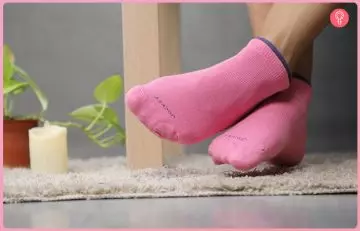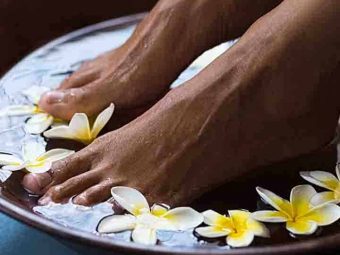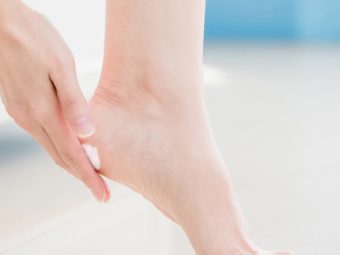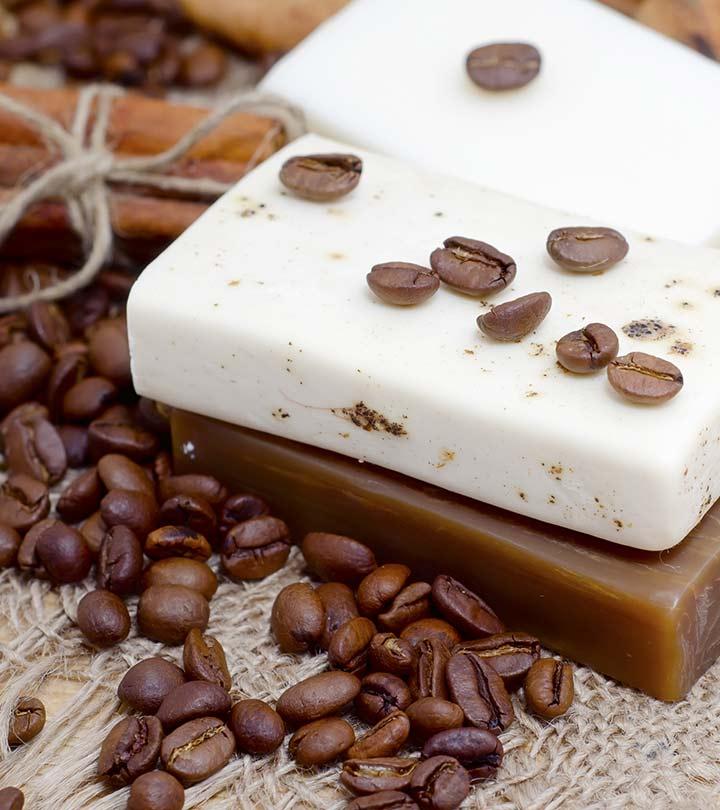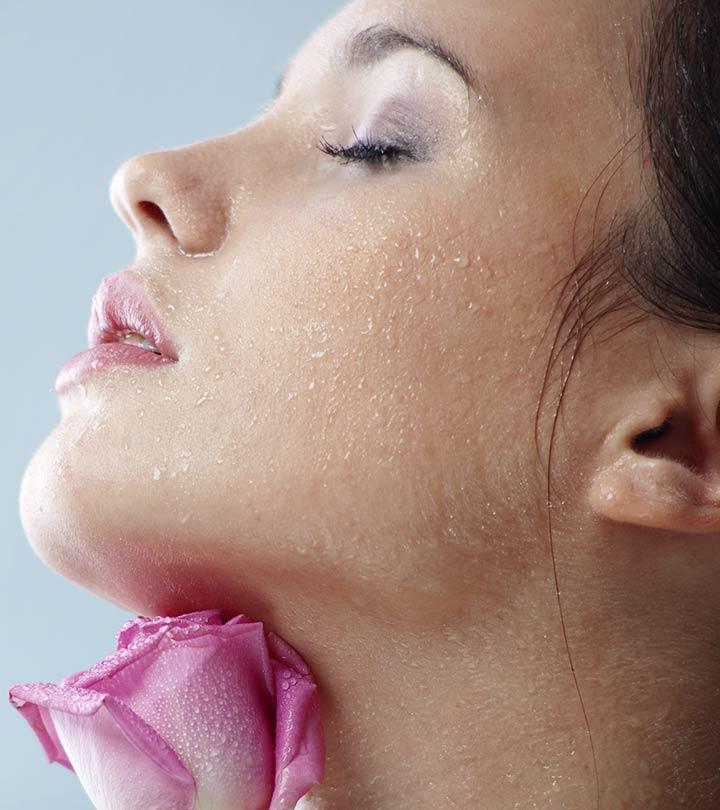How To Remove Dead Skin From Feet
Pamper your feet the way they deserve and get rid of dead skins with these easy methods.

Image: Shutterstock
Hard, dry, and cracked skin under your feet is a common issue among many. Your feet have fewer oil glands than the other areas of your body. They hence experience daily wear and tear, leading to dead skin.
Dead skin on and under the feet may get embarrassing too. But fret not the right treatment methods can help remove the dead skin and restore your feets’ smoother texture. Keep reading to know how to remove thick dead skin from the feet.
In This Article
Various Kinds Of Hard Skin Under The Feet
Various types of hard skin tend to form under your feet due to constant pressure and friction. These are discussed below:
- Corns
Corns are small, round buildups of thick skin areas commonly seen on the tops or sides of your toes. There are several types of corns as listed below:
A survey was conducted with 50,228 participants with the aim of determining which individuals experience more foot pain and the common causes of foot pain in adults, the various reasons being corns, callous, bunions, and foot infections. 56% of participants were classed as overweight, 26.3% had back pain, 23.1% were associated with knee pain, and 11.8% were classed with hip pain. Moderate to severe foot pain was noted in individuals with high obesity, back pain, hip pain, and bunions. The foot pain was significantly worse in such participants and thus hindered proper foot function and foot health.
- Hard Corns
They are small and hard/dense skin areas that usually form within a larger area of thickened skin. They form on the top of
the toes or areas with acute bone pressure against the skin (1).
- Soft Corns
Soft corns are generally whitish or gray and have a softer, rubbery texture. These mostly appear between the toes (1).
- Seed Corns
Seed corns are much smaller and usually form at the bottom of the feet.
- Calluses
Unlike corns, calluses are hard and thick patches of skin. These are larger than corns and have an irregular or spread-out shape (2). They can be mostly seen at the bottom of your foot, on the bony areas that carry your weight (such as the big toe, heel, ball of the foot, or along the side of the foot).
Calluses are also seen on hands too, especially where there is repeated friction or rubbing. Weight lifters, craftsmen, or guitar (or any other musical instrument with strings) players tend to develop calluses on their hands/fingers.
The best way to know if you have corns or calluses is to be aware of their symptoms. We have covered the same in the following section.
Symptoms And Signs Of Corns And Calluses
The major symptoms and signs of corns and calluses include:
- Dry, flaky, and thick areas of skin
- Rounded or conical hard-shaped structures on foot skin
- Foot pain that may interfere with walking or any other physical activity
These symptoms can help you identify if you may have calluses or corns. But what causes them in the first place? Understanding the causes of dry and cracked heels/feet can help you choose the right mode of treatment.
What Causes Dry, Cracked Feet And Heels?
1. Lack Of Moisture
Hard, dry, cracked, and flaking skin is most common on the heels and feet soles as they have the least number of oil glands. These areas do not receive enough moisture.
2. Heat And Humidity
Frequently wearing closed shoes, such as boots and sneakers, can create a humid environment around your feet. Exposing feet to such heat and humidity may draw out the skin moisture and cause them to become thick, dry, and crack.
3. Irritation
Wearing ill-fitting shoes for long hours or standing for too long can also put constant pressure on your feet. It also causes excessive friction against the skin and can make it dry, hard, or calloused.
4. Aging
With age, our skin loses the ability to retain water and becomes thinner and less plump. This is one reason older people going through the natural aging process more frequently experience dry and hard skin.
5. Obesity
Obesity is another cause of dry feet skin simply because the feet carry more weight than usual. This added weight may hinder blood circulation and cause feet to harden.
6. Specific Medical Conditions
Certain medical conditions like psoriasisi XA chronic skin condition that causes itchy, scaly, and rash-like inflamed patches on the skin. , athlete’s foot, eczemai XA skin condition that causes roughness, inflammation, and blisters that may bleed and itch. , and cancer may also cause the skin under the feet to become rough, scaly, and dry. Systemic medical conditions like diabetes and hypothyroidism may also aggravate the problem (3).
7. Excessive Use Of Soaps
Excessive use of soaps and body washes containing harsh chemicals or irritants may suck out moisture from the skin and cause it to go dry and hard. Even failing to wash the excess soap off the feet may lead to dryness.
Yes, hard and dry feet can get quite uncomfortable. But as we discussed, the right treatment methods can help. Read the following section to know more.
Treatment Methods You Can Try To Remove Dead Skin From Your Feet
1. Exfoliate Your Feet
Physical exfoliators include:
- Foot scrubs (you can buy them or make them at home by mixing fruits, honey, sugar, and warm water)
- Electronic callus removers
- Body brushes
Chemical exfoliators include lotions or thin liquids. They generally contain alpha-hydroxy acidsi XA group of plant-derived acids used in skin care products as exfoliants. (like glycolic acid) that dissolve dead cells on the skin surface (4). Foot peels are the other chemical exfoliators that you can try.
Caution: Check the list of ingredients thoroughly as some foot peels contain artificial fragrances and alcohols that may irritate sensitive skin.
Sashie, a YouTuber, demonstrated a quick and effective method for removing dead skin cells from feet using apple cider vinegar and sea salt. After a 30 minute soak, she goes in with her pedicure tools to scrub at her feet, showing, “As you guys can see, my feet are nice and smooth…; they look amazing. As you guys can see, they look smooth, they look soft, they look moisturized (i).” She emphasizes the transformative impact of this self-care routine along with petroleum jelly for the feet, promising to turn dry and cracked feet into soft, beautiful ones.
2. Moisturize Your Feet Regularly
Regularly moisturizing your feet can help reduce existing dry skin and prevent new dry skin from accumulating under the feet surface. Make sure to moisturize your feet after using an exfoliator. You may also use a pumice stone to help the skin seal the moisture (more on this later).
When choosing moisturizing products, look for ones that contain:
- Emollients, which include plant-based butters and oils
- Humectants, such as aloe, urea, and hyaluronic acid
- Occlusives, such as lanolin, petrolatum, and coconut oil (5)
Caution: Avoid moisturizers, creams, and lotions that contain alcohol, artificial colors, and added fragrances. They can worsen dry skin.
3. Use A Pumice Stone Or A Foot File
 Did You Know?
Did You Know?Pumice stones or metal foot files help remove dry, hard skin and calluses from the feet. A pumice stone is a natural lava stone that can help you remove dead skin and calluses from your feet. This is how you can use one:
- Soak the feet in warm water for some time to soften the dead skin.
- Take a pumice stone or foot file and wet it with warm water.
- Rub it gently over the dead skin or callus in a circular motion.
- Rinse the dead skin off the feet and repeat the process if necessary.
- Dry the feet and moisturize them with a good-quality foot cream, lotion, or oil.
Caution: Do not use a pumice stone on injured or sore areas as it can aggravate skin dryness and even cause damage.
4. Soak Feet In Warm Water
Soaking your feet in warm water helps soothe and loosen hard and callused skin. It also improves blood circulation to the feet and may keep the skin from going dry again.
Add a small amount of vinegar to the foot soak. Vinegar may help disinfect your feet and eliminate foot odor. You can also include any of the following ingredients to your foot soak:
- Lemon Juice
The citric acid in lemons is believed to break down the stubborn dead skin and foot calluses. However, research is limited in this regard. Lemons may help smoothen skin (6).
Mix two parts lemon juice with one part sugar. Gently scrub the mixture onto the rough areas, leave it on for 5 to 7 minutes, and rinse with warm water.
Caution: Avoid using lemon on foot skin if you have any injury, cracks, or open wounds. The natural acids in lemons can cause a burning sensation.
- Epsom Salt
Epsom salt is essentially a crystal form of a mineral compound called magnesium sulfate. Dissolve Epsom salt in water and soak your feet in it for 20 minutes. Use a foot brush or a pumice stone to exfoliate your dry and cracked feet. This may help remove dead skin from your feet and also boost skin hydration (7).
- Oatmeal Scrub
Take oatmeal and rose water in equal parts. Mix and gently apply this scrub to your feet. Leave it on for 20 to 30 minutes, use a foot brush to exfoliate the feet, rinse with cold water, and let your feet dry.
5. Use Paraffin Wax
 Quick Tip
Quick TipParaffin wax is a soft wax melted at a medium temperature of 125° F (51°C). It may help remove dead skin from your feet and make the skin softer. However, more research is warranted to further understand this property of paraffin wax.
You can either take a paraffin wax treatment at home using an at-home paraffin wax bath or get it done at a salon that offers a paraffin wax pedicure treatment.
Caution: Do not use paraffin wax treatment in case:
- You have an open sore or rash on your feet
- You have poor blood circulation
- You have lost sensation in your feet
6. Use Aspirin
Crush 4 to 6 aspirin pills into powder form. Mix the powder with a teaspoon of lemon juice and a few drops of water. Gently spread the paste onto the affected areas and leave it on for 5 to 10 minutes. Rinse the area with warm water. Though this method has no scientific backing, it is quite commonly accepted.
7. Wear Moisturizing Socks During Bed Time
Good-quality moisturizing gel-lined socks are a simple answer to your query on how to remove dead skin from the feet. These socks contain natural oils and vitamins that help hydrate and repair the dry skin under your feet. You can get similar results with a good pair of cotton socks and a moisturizer.
Apply a generous amount of moisturizer to your feet and wear a pair of good cotton socks. Remove the socks the next morning and rinse your feet thoroughly.
8. Baking Soda Soak For Feet
A baking soda soak is a natural and effective way to remove dry skin and rejuvenate tired feet. To create the soak, mix 3 tablespoons of baking soda in warm water. Baking soda’s exfoliating properties help slough off dead skin cells, while its alkaline nature softens calluses and rough patches. Soak your feet for 15-20 minutes, allowing the baking soda to loosen dry skin.
After soaking, gently scrub your feet with an exfoliant glove or pumice stone or foot brush to remove the softened dead skin. Pat dry your feet and apply a rich moisturizer or foot cream to lock in the moisture. Regular use of this baking soda soak can leave your feet feeling smoother, softer, and free from rough patches.
Infographic: 5 Easy Ways To Remove Dead Skin From Feet
Factors like heat, humidity, aging, and obesity may contribute to hard and dry skin. The good news is that a few simple remedies can help keep your feet nourished, smooth, and soft. We have rounded up 5 simple methods to remove dead skin from your feet in the infographic below. Take a look!

Illustration: StyleCraze Design Team
Dry and cracked skin may affect your feet’s texture. It may also be painful and affect your physical activities, including walking. In addition, lack of proper moisture, heat, humidity, aging, irritation, obesity, certain medical conditions, and overuse of harsh soaps may cause these corns and calluses under your feet. So, if you want to know how to get rid of dead skin on the feet, you simply have to exfoliate, moisturize and take proper care of them.
Follow the foot care tips discussed in the article and if the symptoms persist, consult your doctor.
Frequently Asked Questions
Should you cut off the dead skin on your feet?
You should not cut, pinch, or forcibly pull out any hard dead skin buildup on your skin. Instead, you may use any of the above methods to help soften the skin and exfoliate the dead skin out gently.
Is vaseline good for feet?
Yes, anecdotal evidence suggests that applying Vaseline on dry, cracked feet and leaving it on overnight can help seal your skin’s natural moisture while making it smooth and soft.
Is toothpaste good for feet?
With its tiny abrasive particles, toothpaste might help enhance the exfoliating effects of a foot file or pumice stone. However, it would be best if you did not use it as a traditional home remedy to treat dead skin on the feet.
Key Takeaways
- Lack of moisture, harsh soaps, and medical conditions like eczema can cause dry and flaking skin on feet and heels.
- Chemical exfoliation, pumice stone, and regular moisturization are some of the common methods to remove dead skin from feet.
- To ensure extra hydration, you can use moisturizing gel-lined socks while going to bed.
- Soak your feet in lukewarm water to soften hard and callused skin, improve blood circulation, and avoid dryness.

Image: Stable Diffusion/StyleCraze Design Team
Learn how to get rid of dead skin on the bottom of your feet with this easy video tutorial. Dive into it to help you get soft and smooth feet in no time.
Personal Experience: Source
StyleCraze's articles are interwoven with authentic personal narratives that provide depth and resonance to our content. Below are the sources of the personal accounts referenced in this article.
i. HOW TO REMOVE DEAD SKIN CELLS FROM YOUR FEET IN MINUTES | Self Care Routinehttps://www.youtube.com/watch?v=ODgECTTZ3OE
References
Articles on StyleCraze are backed by verified information from peer-reviewed and academic research papers, reputed organizations, research institutions, and medical associations to ensure accuracy and relevance. Read our editorial policy to learn more.
- Corns
https://www.ncbi.nlm.nih.gov/books/NBK470374/ - The evaluation of three treatments for plantar callus: a three-armed randomised, comparative trial using biophysical outcome measures
https://www.ncbi.nlm.nih.gov/pmc/articles/PMC4869362/ - Dermatologic manifestations of endocrine disorders
https://www.ncbi.nlm.nih.gov/pmc/articles/PMC5682371/ - Skin Care with Herbal Exfoliants
https://www.researchgate.net/publication/224892687_Skin_Care_with_Herbal_Exfoliants - Moisturizers: The Slippery Road
https://www.ncbi.nlm.nih.gov/pmc/articles/PMC4885180/ - Citrus limon (Lemon) PhenomenonA Review of the Chemistry, Pharmacological Properties, Applications in the Modern Pharmaceutical, Food, and Cosmetics Industries, and Biotechnological Studies
https://www.ncbi.nlm.nih.gov/pmc/articles/PMC7020168/ - Bathing in a magnesium-rich Dead Sea salt solution improves skin barrier function, enhances skin hydration, and reduces inflammation in atopic dry skin
https://pubmed.ncbi.nlm.nih.gov/15689218/














